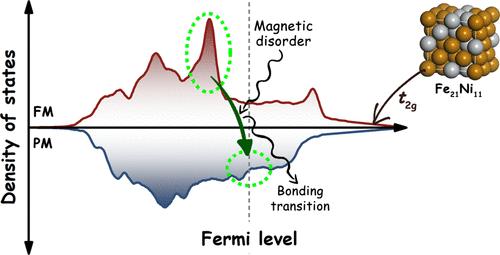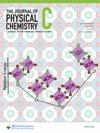Bonding Transition Mechanism in Invar Alloy Induced by Noncollinear Magnetic Disorder: DFT+U Insights
IF 3.3
3区 化学
Q2 CHEMISTRY, PHYSICAL
引用次数: 0
Abstract
The Fe–Ni Invar alloy is extensively utilized in industry due to its nearly zero thermal expansion coefficient at room temperature. Concurrently, the origin of the Invar effect has been a subject of continuous investigation for over a century. There is currently increasing interest in the connection between noncollinear magnetism and the Invar effect, but the underlying physical mechanism remains unclear. In this work, systematic DFT+U calculations confirm that the spontaneous magnetostriction of Invar alloy can be well evaluated with a suitable Hubbard U correction. Constrained DFT combined with atomic spin dynamics is employed to verify the longitudinal spin attenuation behavior (i.e., the reduction of moment magnitude) induced by the magnetic disorder in the noncollinear magnetic structure model. These extraordinary phenomena related to the Invar effect can be attributed to the transition mechanism of atomic bonding characteristics, primarily manifested by the transformation of the localized antibonding states to the nonbonding states in the Fe atom pairs by crystal orbital Hamilton population analysis. Furthermore, the electronic structure calculations indicate that with the enhancement of noncollinear orientation disorder, there is electron transfer from antibonding states to nonbonding states near the Fermi level. The bonding transition mechanism provides a simple and effective pattern for understanding the Invar effect.

非共线性磁紊乱诱导英达合金中的键合转变机制:DFT+U 见解
铁-镍因瓦合金在室温下的热膨胀系数几乎为零,因此被广泛应用于工业领域。与此同时,一个多世纪以来,人们一直在研究因瓦效应的起源。目前,人们对非共轭磁性与因瓦效应之间的联系越来越感兴趣,但其基本物理机制仍不清楚。在这项工作中,系统的 DFT+U 计算证实,通过适当的 Hubbard U 修正,可以很好地评估因瓦合金的自发磁致伸缩。约束 DFT 与原子自旋动力学相结合,验证了非共轭磁结构模型中磁性无序引起的纵向自旋衰减行为(即磁矩大小的减小)。这些与因瓦效应相关的非凡现象可归因于原子成键特性的转变机制,通过晶体轨道汉密尔顿种群分析,主要表现为铁原子对中局部反键态向非键态的转变。此外,电子结构计算表明,随着非共线取向无序性的增强,费米水平附近存在着从反键态向非键态的电子转移。成键转变机制为理解因瓦效应提供了一个简单而有效的模式。
本文章由计算机程序翻译,如有差异,请以英文原文为准。
求助全文
约1分钟内获得全文
求助全文
来源期刊

The Journal of Physical Chemistry C
化学-材料科学:综合
CiteScore
6.50
自引率
8.10%
发文量
2047
审稿时长
1.8 months
期刊介绍:
The Journal of Physical Chemistry A/B/C is devoted to reporting new and original experimental and theoretical basic research of interest to physical chemists, biophysical chemists, and chemical physicists.
 求助内容:
求助内容: 应助结果提醒方式:
应助结果提醒方式:


